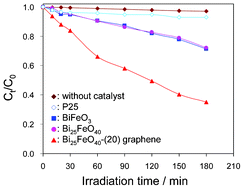Magnetic Bi25FeO40-graphene catalyst and its high visible-light photocatalytic performance†
Abstract
Magnetic Bi25FeO40-graphene visible-light photocatalysts were prepared by a one-step alkaline

* Corresponding authors
a
School of Environmental and Biological Engineering, Nanjing University of Science and Technology, Nanjing 210094, PR China
E-mail:
fjiang@njust.edu.cn
Fax: +86-25-84315352
Tel: +86-25-84311819
b Key Laboratory of Soft Chemistry and Functional Materials, Nanjing University of Science and Technology, Ministry of Education, Nanjing 210094, PR China
Magnetic Bi25FeO40-graphene visible-light photocatalysts were prepared by a one-step alkaline

 Please wait while we load your content...
Something went wrong. Try again?
Please wait while we load your content...
Something went wrong. Try again?
A. Sun, H. Chen, C. Song, F. Jiang, X. Wang and Y. Fu, RSC Adv., 2013, 3, 4332 DOI: 10.1039/C3RA22626C
To request permission to reproduce material from this article, please go to the Copyright Clearance Center request page.
If you are an author contributing to an RSC publication, you do not need to request permission provided correct acknowledgement is given.
If you are the author of this article, you do not need to request permission to reproduce figures and diagrams provided correct acknowledgement is given. If you want to reproduce the whole article in a third-party publication (excluding your thesis/dissertation for which permission is not required) please go to the Copyright Clearance Center request page.
Read more about how to correctly acknowledge RSC content.
 Fetching data from CrossRef.
Fetching data from CrossRef.
This may take some time to load.
Loading related content
